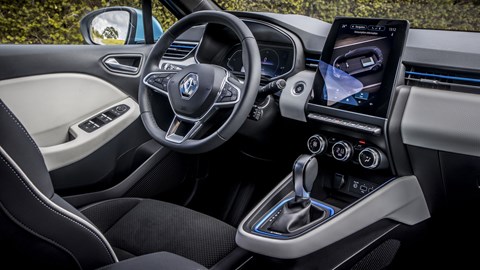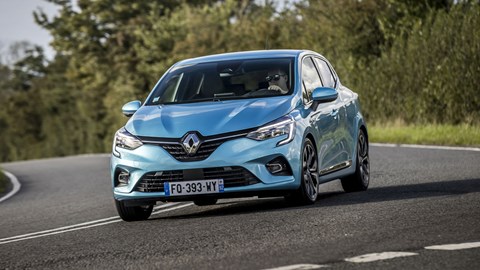► Hybrid Renaults about to hit UK
► All about the new E-Tech Clio
► Plug-in Captur and Megane too
Renault's new Clio E-Tech hybrid is the flagship of the range in the way Renaultsport versions used to be, says the firm's UK managing director. Vincent Tourette spoke to CAR as Renault begins the roll-out here of electrified versions of Clio, Megane and Captur.
Priced from £19,595 and with deliveries beginning in October 2020, the hybrid Clio riffs on a Formula 1 drivetrain with its multi-mode clutchless gearbox and twin electric motors, one to help power the car, the other to recuprate energy and start it. Read on for more technical details.
UK boss talks Clio and E-Tech
'There's no Renaultsport version, but these are different times and the Clio e-Tech will do that job and is more in line with today's needs,' says Vincent Tourette. Zeitgeisty electrification helps reduce CO2 emissions to 98g/km, with fuel consumed at a similar rate to a diesel. One of Europe's first small hybrid cars, the Clio is priced between new versions of the Japanese stalwarts that established the small hybrid segment, the £18,985 Honda Jazz and £20,970 Toyota Yaris.

Tourette estimates the E-Tech version will account for about 20% of Clio sales next year. The plug-in hybrid versions of Captur and Megane will provide closer to 10% of registrations: priced from £30,495 and £30,685 respectively, and with zero road tax and reduced company car tax due to their low CO2 emissions (30g/km), these cars will be predominantly bought by company fleets.
The UK boss is striving for the new Clio to become the force it was in the days of the Papa and Nicole adverts, when Renault was the UK's third best-selling brand. 'Clio has been well below where it should have been in this market and we are working hard to take it back in the top 10 definitely, maybe in the top five,' says Tourette. 'Since June, the order take has been flying. The good news is that the market seems to be back and I would say quite strongly back – the market is ahead of our forecasts which is good news.'
More on Renault E-Tech?
Renault has come up with an interesting new approach to hybrids, to overcome packaging issues and the torque and engine noise compromises that come with using an Atkinson cycle engine and a CVT transmission.
Renault's target was to engineer a new drivetrain with better economy and lower emissions than a diesel engine and more range than an electric car. One that fits in a Clio, without impacting boot or passenger space, and doesn't cost something silly like £30,000.

A hybrid was the obvious choice, but there’s no room in the engine bay for the CVT auto ’box generally used in hybrids, let alone all the other electric gubbins. So what Renault has come up with for its first hybrid is a petrol engine with two auxiliary electric motors and a multi-mode clutchless dog ’box. Like a Formula 1 car.
The petrol engine is a 1.6-litre naturally aspirated four from Nissan previously found in the Dacia Duster, but here featuring hybrid-specific injection and camshaft timing, plus a cooled EGR (exhaust gas recirculation) system.

It weighs about 10kg more than a dCi 115 engine but produces 98g/km of CO2, and because the 1.2kWh battery is hidden between the rear wheels, you get the same 300-litre boot.
Performance comes in the form of 138bhp from the petrol engine and main electric motor (which contributes 48bhp), while a second electric motor (making 20bhp) takes care of brake regeneration, starting the engine, and powering the four-speed gearbox. Because there’s no clutch, each gearshift needs to be rev-matched.
The clever/complicated bits
Unlike most electric cars – but like the Porsche Taycan – the Clio has a pair of ratios for the electric drivetrain. Think of it as two gearboxes in one: one for internal combustion and one for electric, with the ability to disconnect one type of power for full petrol or full electric motion.
The Clio E-Tech always starts in electric mode, and Renault says it’ll spend 80% of its town driving there too.
Driving the E-Tech prototype
We've briefly driven a prototype Clio, and there will be a full review of the production Clio E-Tech on CAR on Wednesday 2 September 2020.
The protoype is very responsive in electric mode from the off, but becomes vaguer at speed. Coming off the gas to slow down, you’ll notice a bit of a delay before the regeneration starts. And sometimes after you press the accelerator there’s a delay while it works out what variety of drive it wants. The shifts between modes are, however, very smooth.

In short it’s much better than a typical CVT-based hybrid system, with better pick-up and refinement. And compared to a non-hybrid Clio, Renault predicts up to 40% better fuel economy.
Renault’s first hybrid at a glance
Modular platform
Mk5 Clio range designed to include a hybrid, so the battery can be added without eating boot space
Recycled engine
Petrol four is a relatively simple Nissan design that’s already served Dacia well. Good job the Alliance is holding up…
And there are plug-ins
Although the Clio’s hybrid system isn’t plug-in, the Megane and Captur’s are (above). They uses much the same kit but have a bigger battery, and up to 30 miles of EV range